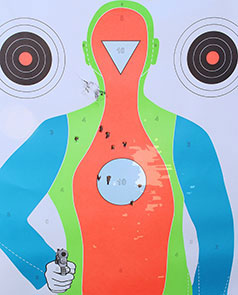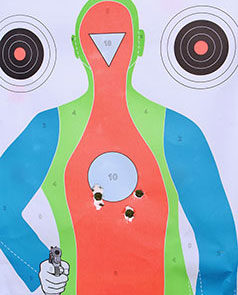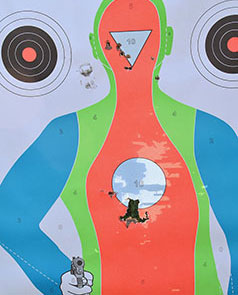Shotguns vs. Rifles
Comparing shotguns to rifles is like comparing apples to oranges. They are very different and we need both for a healthy diet. In today's urban and suburban environments the most appropriate tactical rifle is one that is chambered in 5.56X45mm. NATO and/or .223 Rem. These relatively small .22 caliber centerfire cartridges are good choices for population centers because most of the loads in these calibers present the least possibility of collateral damage due to ricochet and overpenetration of any centerfire rifle cartridges. They are also quite controllable in both automatic and semi-automatic fire compared to most other centerfire rifle cartridges. However, the .223 Rem. and 5.56X45mm. were designed for maximum terminal-effectiveness when fired from a rifle with a 20" barrel. Most tactical rifles used in law enforcement today have barrels that are between 7.5" and 16". Unfortunately, reducing a rifle's barrel length can significantly reduce the bullet's muzzle velocity and energy, limiting the bullet's terminal performance.
Twelve gauge shotguns do not lose terminal performance as rapidly as.22 caliber centerfires when the barrel is shortened. In addition, a 12 gauge gun delivers a payload that is up to eleven times greater than that of a .22 caliber centerfire. So even a 12 gauge shotgun with a 14" barrel is likely to have a significantly greater terminal effect on the target at close quarters than a short-barreled .223 or 5.56X45mm. rifle. The down side of shotguns is that they hold fewer rounds than tactical rifles, so they must be reloaded more often. And, the low ballistic coefficient of shotgun projectiles limits tactical buckshot's maximum effective range to about 25 yards and the effective range of tactical slugs to 50 or perhaps 75 yards. Depending on barrel length and bullet design, most .223 Rem. or 5.56X45mm. NATO caliber rifles are effective to between 200-500 yards due to the much higher ballistic coefficients of various .224 caliber bullets.
What does all of this mean for law enforcement officers operating in urban and suburban areas? The short answer is that an agency needs to deploy both shotguns and rifles when dealing with tactical situations for which long guns are appropriate. For example, when serving a warrant on allegedly armed suspects in a building, a 12 gauge shotgun is the gun of choice for breaching doorways. In addition, a tactical shotgun has a greater on-target effect when engaging dangerous individuals at very close range in small rooms and hallways. The 12 gauge also generates less flash and blast than a .22 caliber centerfire rifle because the shotgun's lower bore expansion ratio causes more of the gunpowder contained in the shotshell to burn in the barrel. On the other hand, rifles are superior for precision shooting during hostage rescue attempts, for engaging active shooters in crowded areas and for generating suppressive fire. Ideally, a multiple officer response should have officers equipped with shotguns and officers with rifles.
 |
 |
 |
The 7" group was fired using a conventional 9 pellet buckshot load in a Remington870 Tactical shotgun equipped with a Cylinder bore extended tactical choke tube. |
This 2.75" 50 yd. group was fired from a Remington 870 tactical shotgun from a bench rest using Federal's Low Recoil 12 gauge Truball slugs and a Cylinder bore extended tactical choke tube. |
The head and chest groups on this target were fired at 15 yards using Federal's 12 gauge 8-pellet low recoil Personal Defense load in a Remington870 Tactical shotgun equipped with a Cylinder bore extended tactical choke tube. |
